Last week I was asked by my uncle and aunt to house sit for them while they went holidaying in South Australia for a couple of weeks. I jumped at the opportunity, because the house is close to the city and university, and it would give me some peace and quiet to intensely work on my honours thesis, whose due date is fast approaching. The house is newly renovated, so I went there before they left to learn the ins and outs of the new living area and get a rundown of the house maintenance. While I was being shown the new kitchen, I was introduced to the latest addition to the family and what would be the demise of my intended thesis work – the Thermomix. I am very interested in learning about the latest technology, and I love food and cooking, so I knew straight away that the Thermomix, which brings clever technology into the domestic kitchen, would certainly be stealing some of the time that I would otherwise have been using to finish my work.

Thermomix interior (left), front (middle) and control pad (right)
The Thermomix is something of an all-in-one type appliance. It is essentially a food processor with a heating element with inbuilt scales, so that it can measure the mass of something, chop, stir, puree and knead, while at a specified temperature of up to 100 degrees Celcius. It seems to have really sold itself as a convenience product around the world and raised the standard in the “dump and leave alone” style of cooking, whereby home cooks can just put the ingredients into the stainless steel Thermomix bowl, adjust the temperature and speed settings, and then go and watch some TV with a glass of wine until the alarm indicates that dinner is ready. The Thermomix has made some appearances on MasterChef Australia, which is where I first learned of its existance.
When I moved into my new temporary home, I was deciding what I should make first. What excited me most about the Thermomix was its ability to regulate the temperature of a liquid with a reasonable degree of accuracy. Temperature controlled cooking seems to be gaining in prominence in the domestic kitchen and in the culinary media, with the availability of accurate digital thermometers, domestic water baths and, of course, the Thermomix. Cooking for a longer amount of time but at a lower temperature has the ability to change the texture of certain foods, and can be employed as a means of getting the perfect results every time. It was time for breakfast, so I decided to make slow-cooked eggs, which are cooked for an hour at 60 degrees Celcius. It was literally a matter of putting two eggs into the Thermomix filled with water (I inserted the simmer basket to keep the eggs raised), setting the temperature to 60 degrees, setting a time of 60 minutes, and then walking away.
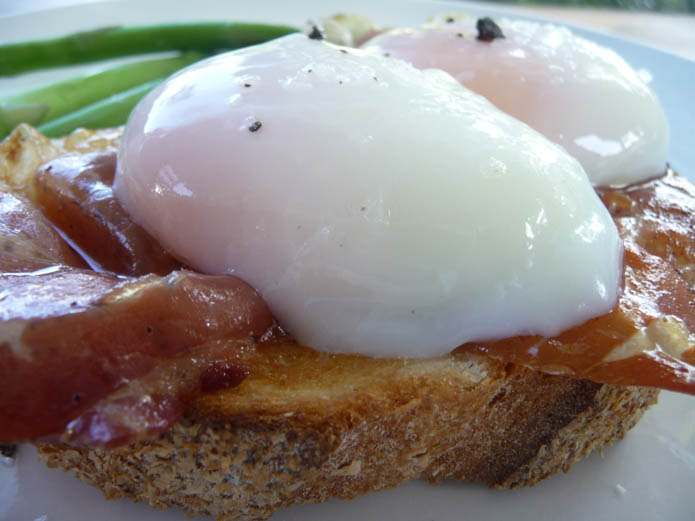
Slow cooked eggs on toast with culatello and black truffle
Cooking eggs slowly like this results in an amazing texture. They end up with a perfectly silky yolk, but the egg white also remains soft and almost fluid, unlike when it is poached out of the shell. Serving the eggs is so easy too. I just cracked them into a bowl like I would an ordinary raw egg, discarded any loose egg white, and then slid them onto my toast. I served them with some gently fried culatello prosciutto (culatello is probably one of the most prized cured meats, coming from the back of the rear leg of a pig. I would not normally apply heat to such an amazing product, but in this case I wanted to accentuate its saltiness), blanched asparagus, and a sprinkle of sea salt with chopped truffles. I am salivating just thinking about it, and I want to have breakfast again right now. Eggs on toast is so simple, yet the result can be so varied, depending on how the eggs are cooked. This is definitely a point for the Thermomix.
Next up was a risotto for dinner. My absolute favourite risotto is Risotto alla Milanese, a saffron flavoured risotto originating from Milan. Three of my grandparents came from places near Milan, so naturally I grew up eating this dish quite often (they call it “riso giallo”–literally “yellow rice”). I am a bit of a stickler for tradition and like to cook my risotto by standing over the stove, slowly adding stock in batches and continuously stirring; there is something mesmerising about it. Given that I needed to recover some of the time that I should have spent working on my thesis, I decided to make riso giallo and let the Thermomix do all the work.
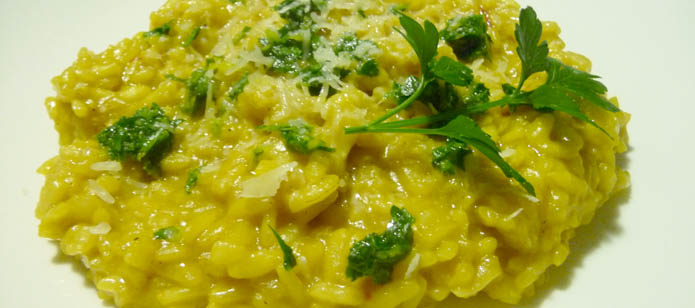
Risotto alla Milanese with gremolata. The long grains are a characteristic of carnaroli rice
For this I used carnaroli rice, often considered the “re dei risi”, or “king of rices”. Carnaroli rice is produced in Lombardia and Piemonte, in the north-western parts of Italy. Although not as prominent as aborio rice in the supermarkets here in Perth, there are a few gourmet vendors (and upmarket supermarkets) that stock it. I served it with a gremolata to add an extra kick.
It was time for something a little sweeter. I was going to have some friends over one night after dinner, and wanted to make sure there was something to eat. I’m not sure why, but ice cream seemed like a good choice. Most people would probably just head to the supermarket and buy a tub of it, but I decided instead to use the opportunity to make my own. All I had to do was add the eggs, milk, cream and sugar to the Thermomix and 10 minutes later I had crème anglaise, to which I added some Nutella to give the choc-hazelnut flavour, which I then froze and churned to make ice cream.
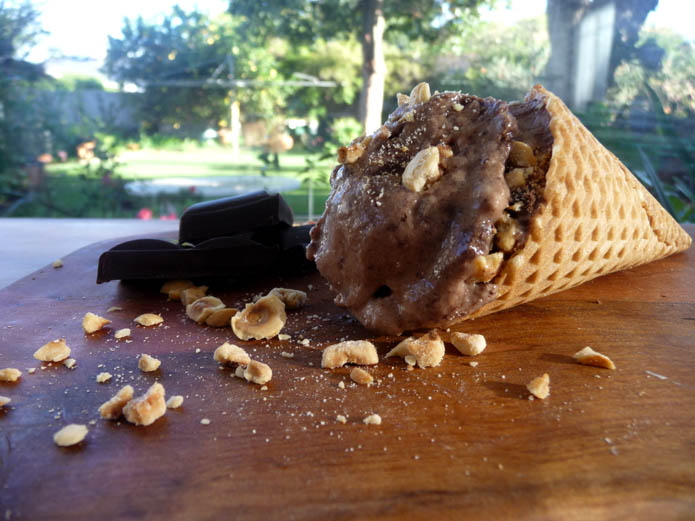
Chocolate and hazelnut ice cream served in a waffle cone
I didn’t stop at just one dessert of course. Sitting next to the stove was a great book by Dani Valent (In the Mix), completely dedicated to Thermomix cooking. Although the recipes are not quite “dump and leave alone” (often requiring a multitude of ingredients, or five individual components in some cases), there are some really great ones in there. I decided to try her Caramelised White Chocolate Mousse with Passionfruit Curd and Coffee Crumb.

Caramelised white chocolate mousse and coffee crumbs on a layer of passionfruit curd. Garnished with mint leaves.
The mousse was made by cooking white chocolate for just under an hour so that the sugars transform and impart a caramel flavour to the mousse. Whipped cream is folded through, along with a small amount of gelatin to give it a firm texture. Underneath the mousse layer is some passionfruit curd, which adds a fruity tartness element to balance the richness. On the top is a coffee flavoured biscuit crumb that adds a great textural element.
I was impressed with the chocolate mousse recipe, so decided to use the book again the next morning for breakfast. In the breakfast chapter is a recipe for crumpets, which, perhaps surprisingly to some, don’t only come from a packet from the supermarket and go straight into the toaster–they can actually be made fresh at home! The recipe really couldn’t have been much simpler to follow; it was a matter of measuring out the ingredients and throwing them into the Thermomix for a beating. After letting the yeast do its work for an hour, the mixture was ready to be poured straight on to the frying pan into the egg rings.
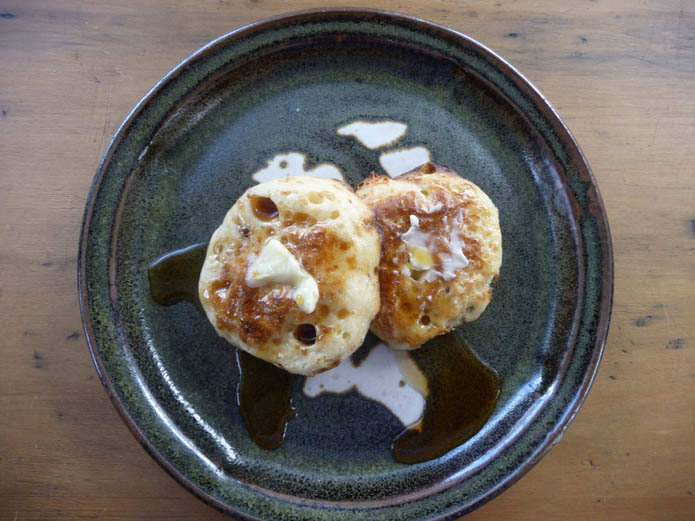
Crumpets with butter and maple syrup
These turned out so much nicer than the packaged sponges from the supermarket. The exterior was crisp, while the interior was doughy and porous, perfect for absorbing lashings of maple syrup and butter. The recipe actually produced way more crumpets than I could handle (I was just having a romantic breakfast-for-one that morning) so I decided to freeze the rest and leave a (hopefully) nice surprise in the freezer for my uncle and aunt.
After making the ice cream, I had a whole bowl of egg whites left over. Normally I would just freeze them until I actually have a need for them, rather than forcing myself to make something for the sake of using them up. One of my favourite things to make with egg whites are my Brutti Ma Buoni Biscotti (literal Italian translation for “Ugly But Nice Biscuits”). I found a recipe for these a while ago while browsing the Italian YouTube and have been making them ever since. The name comes from the fact that they are not the most elegant looking biscuits, but they taste amazing. A soft chewy interior with a crispy outside shell. The Thermomix was perfect for these because making the biscuit mixture is not unlike making a risotto–it takes continuous stirring over a low heat. I just set the Thermomix to 90 degrees Celsius and left it for about 20 minutes.
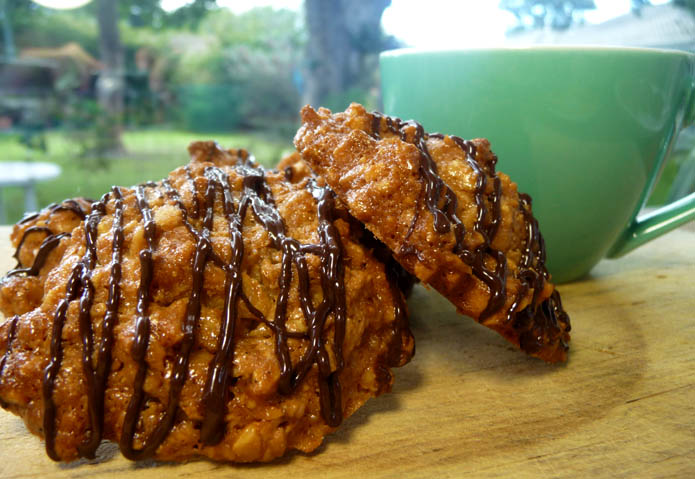
Brutti Ma Buoni Biscotti go perfectly with a cup of Earl Grey
Although I didn’t get any photos, I also used the Thermomix temperature regulation to make confit salmon for lunch and a sous vide steak for dinner. These require a level of temperature precision that is difficult to maintain without some kind of advanced control system, and this is exactly what the Thermomix offers.
Although I don’t think it is quite capable of replacing everything in a kitchen, the Thermomix certainly is a workhorse. I still prefer using a knife to chop things with a certain precision and uniformity, however the temperature control and continuous stirring are probably some of the most useful things in a kitchen. It is probably the perfect tool for somebody with very minimal kitchen space, such as in a small apartment.
Fabulous review! Glad you enjoyed using the Thermomix!
Thanks Kylee 🙂 I think I’m going to have to buy one of my own!
Omggggg Daniel, MARRY ME, your food looks so amazing!!!!!! Loving the blog btw, very entertaining and informative read 🙂
Haha thanks Marie 😀 I’m really glad you found it interesting! Hopefully I can keep it up 🙂
I love this review of the Thermomix! We have on & don’t use it as much as we should. I’d be interested to know temperature & timing of the sous vide salmon. I need to try that one! It’s great seeing the device in a new light & being reminded of how much it can do 🙂
Thanks for the comment Liv 🙂 The salmon was actually confit and not sous vide, because no vacuum sealing was used (I just did the steak sous vide, at a temperature of 60 degrees Celsius). I followed the recipe from Dani Valent’s InTheMix (the first one), in which she proposes a method of putting the salmon into a plastic bag with olive oil and flavourings and then cooking it slowly in the varoma dish with the varoma temperature setting. I can’t remember the exact timing, however the book describes it in detail. Actual sous vide salmon should be quite easy I’d imagine though, with a temperature setting of 50 or 60 degrees Celsius.
Hi Daniel,
Thanks for sharing your culniary experience in using the Thermomix. I have been an user since Nov 2013.
Do you remember how long you whipped the egg whites in the Thermomix to make Brutti Ma Buoni? Was it about 3 – 4 minutes on speed 4? I like your photo because it looks exactly the same as the one I bought at my favourite cafe in Brisbane. 🙂 I fell in love with it at first bite. 😀
Thank you.
Best regards,
Kathy
They are indeed easy to fall in love with 🙂 I have made these for friends, family and colleagues many times, always with great reviews!
AS for the speed and time, unfortunately I don’t remember exactly what settings I used. Because it was my first time whipping egg whites in the Thermomix, I just experimented a bit until they had the right texture. The key is to bring them to the point of “soft peaks”, where the foam has just enough structure to start supporting the formation of peaks.